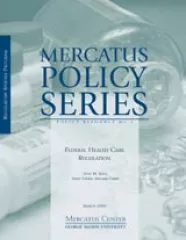- | Healthcare Healthcare
- | Expert Commentary Expert Commentary
- |
Health Care Plan Rebates Have Hidden Costs
Some consumers and businesses might see a little extra cash this summer as a result of the 2010 health care law. What people don’t realize is that there’s a catch to this “free” money.
This article originally appeared in Roll Call
Some consumers and businesses might see a little extra cash this summer as a result of the 2010 health care law. The Kaiser Family Foundation recently reported an estimated $1.3 billion in rebates will be delivered from health insurers who spent more than the law allotted on administrative expenses and profits.
What people don’t realize is that there’s a catch to this “free” money. The rebates are required by an obscure regulation in the health care law, called the “minimum loss ratio,” which also contains longer-term incentives for health insurers to increase costs that will be passed along to all of us. Instead of rushing to spend these extra dollars, rebate recipients are better off pocketing it to pay for higher premiums in the future.
The regulation is supposed to benefit policyholders by limiting what insurance companies can spend on administrative costs and marketing expenses — and by limiting profits. It requires insurance companies to pay a specified percentage of their premium income — usually 80 percent or 85 percent — for health care (or initiatives that will improve the quality of health care). So if an insurer spends only 84 cents of each premium dollar on health care benefits instead of 85 cents, it would have to rebate the difference to consumers. With the typical family health insurance premium now exceeding $15,000, that one percent difference could amount to $150.
Unfortunately, the regulation contains several incentives that actually discourage activity that clearly benefits the policyholder.
For example, insurance company expenses to prevent fraud are considered “bad” administrative costs. Suppose an insurance company is right at the maximum allowed spending on administrative costs, but it needs to spend an extra $100 to prevent $1,000 worth of fraud. It won’t, because it will get penalized.
Because fraud accounts for 3 percent to 10 percent of total health care spending, according to the National Health Care Anti-Fraud Association, we ought to be doing everything possible to prevent it rather than creating incentives to catch it only after the fact. Which do you think is more cost-effective? Putting a lock on your door to prevent burglaries or leaving your door open and paying cops to track down your stolen goods?
This requirement is a step toward regulating health insurance companies like electric or gas utilities. Traditionally, regulators have tried to let these companies cover their costs plus earn a “reasonable” profit. Experience shows us, however, that when regulation limits profits and allows companies to pass on costs to consumers, it kills the incentive for cost control. The easiest way for a company to make profits look reasonable in relation to costs is to raise prices.
Although health insurers will pay some rebates this year, the cash should be treated as a short-term benefit with a long-term cost. Rebates will likely disappear in the future as the companies become more familiar with the regulation and learn how to game it.
To do this, they don’t even have to be dishonest; they just have to get lazy. A health insurer can keep more profits by simply getting lax about how much it pays for medical procedures. For example, 85 percent of a $16,000 annual family premium leaves a bigger profit than if the premium were only $15,000. As long as the company can convince regulators that the cost of medical care has gone up, it can justify higher premiums.
These consequences are just another reason regulations need to receive more careful consideration. By fast-tracking the health care law, Congress and the administration took the chance to put cash in some voters’ pockets right before a major election while postponing a poorly understood and opaque cost until later. This is how the political system too often works, and it rarely benefits those who are not on the campaign trail. Let the voter beware.
